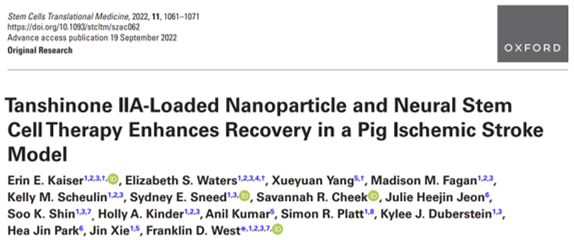Publications
-

Human mitochondrial DNA mutations are associated with common to rare mitochondrial disorders, which are multisystemic with complex clinical pathologies. The pathologies of these diseases are poorly understood and have no FDA-approved treatments leading to symptom management. Leigh syndrome (LS) is a pediatric mitochondrial disorder that affects the central nervous system during early development and causes…
Posted in: Publications -

This study aims to uncover important biomarkers and stroke recovery patterns based on physiological changes by developing two sparse CCA methods for multiple datasets. In analyzing the pig stroke data, we apply the proposed sparse CCA methods along with dimension reduction techniques, interpret the recovery patterns, and identify influential variables in recovery. Please click on…
Posted in: Publications -

Pediatric traumatic brain injury (TBI) is a leading cause of death and disability in children. Due to bidirectional communication between the brain and gut microbial population, introduction of key gut bacteria may mitigate critical TBI-induced secondary injury cascades, thus lessening neural damage and improving functional outcomes. The objective of this study was to determine the…
Posted in: Publications -

Impaired gut homeostasis is associated with stroke often presenting with leaky gut syndrome and increased gut, brain, and systemic inflammation that further exacerbates brain damage. We previously reported that intracisternal administration of Tanshinone IIA-loaded nanoparticles (Tan IIA-NPs) and transplantation of induced pluripotent stem cell-derived neural stem cells (iNSCs) led to enhanced neuroprotective and regenerative activity…
Posted in: Publications -

Functional connectivity (FC) measures statistical dependence between cortical brain regions. Studies of FC facilitate understanding of the brain’s function and architecture that underpin normal cognition, behavior, and changes associated with various factors (e.g. nutritional supplements) at a large scale. We aimed to identify modifications in FC patterns and targeted brain anatomies in piglets following perinatal…
Posted in: Publications -

In this study, we sought to further understand how nutritional supplements influence specific brain function and architecture as well as cognitive and behavioral performance. Specifically, we aimed to identify modifications in functional connectivity (FC) patterns and targeted brain anatomies in piglets following perinatal intake of different nutritional diets using a graph theory based approach where…
Posted in: Publications -

Human mitochondrial DNA mutations are associated with common to rare mitochondrial disorders, which are multisystemic with complex clinical pathologies. The pathologies of these diseases are poorly understood and have no FDA-approved treatments leading to symptom management. Leigh syndrome (LS) is a pediatric mitochondrial disorder that affects the central nervous system during early development and causes…
Posted in: Publications -

Induced pluripotent stem cell-derived neural stem cells (iNSCs) are a multimodal stroke therapeutic that possess neuroprotective, regenerative, and cell replacement capabilities post-ischemia. However, long-term engraftment and efficacy of iNSCs is limited by the cytotoxic microenvironment post-stroke. Tanshinone IIA (Tan IIA) is a therapeutic that demonstrates anti-inflammatory and antioxidative effects in rodent ischemic stroke models and…
Posted in: Publications -

Dynamic changes in the oral microbiome have gained attention due to their potential diagnostic role in neurological diseases such as Alzheimer’s disease and Parkinson’s disease. Traumatic brain injury (TBI) is a leading cause of death and disability in the United States, but no studies have examined the changes in oral microbiome during the acute stage…
Posted in: Publications -

Functional magnetic resonance imaging (fMRI) has significant potential to evaluate changes in brain network activity after traumatic brain injury (TBI) and enable early prognosis of potential functional (e.g., motor, cognitive, behavior) deficits. In this study, resting-state and task-based fMRI (rs- and tb-fMRI) were utilized to examine network changes in a pediatric porcine TBI model that…
Posted in: Publications